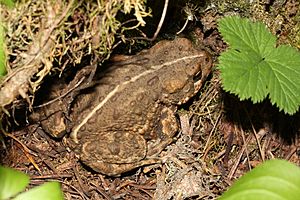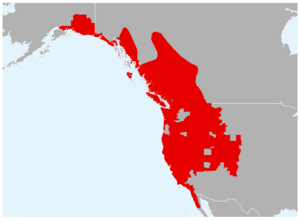Western toad facts for kids
Quick facts for kids Western Toad |
|
|---|---|
 |
|
| In Mount Baker-Snoqualmie National Forest | |
| Conservation status | |
| Scientific classification | |
| Kingdom: | |
| Phylum: | |
| Class: | |
| Order: | |
| Family: | |
| Genus: | |
| Subgenus: |
Anaxyrus
|
| Species: |
A. boreas
|
| Binomial name | |
| Anaxyrus boreas Baird & Girard, 1852
|
|
 |
|
| Synonyms | |
|
Bufo boreas |
|
The Western toad (Anaxyrus boreas) is a type of toad found in western North America. These toads are quite large for their kind. They can grow to be between 5.6 and 13 centimeters long. They are a common sight in many parts of the western United States and Canada.
Contents
What is a Western Toad?
Western toads are amphibians. This means they can live both on land and in water. They are known for their bumpy skin and squat bodies. Unlike frogs, toads usually have drier, warty skin. They also tend to walk or make short hops instead of long jumps.
Appearance
Western toads have a special look that helps you spot them. They often have a light stripe down their back. Their skin color can be green, brown, or gray. This helps them blend in with their surroundings. A key feature is their oval-shaped parotoid glands. These glands are located behind their eyes. They release a milky substance that can taste bad to predators.
Where Western Toads Live
These toads live in many different places. You can find them in forests, grasslands, and even deserts. They need access to water for breeding. So, they are often near ponds, lakes, or slow-moving streams. They are found from Alaska down to Baja California.
Life Cycle
Western toads start their lives in water. The female toad lays long strings of eggs. These eggs hatch into tiny tadpoles. Tadpoles live in the water and breathe with gills. They eat algae and other small bits of plants.
As they grow, tadpoles slowly change. They develop legs and their tails get shorter. Eventually, they lose their gills and grow lungs. This allows them to breathe air. Once they are fully grown, they leave the water. They then spend most of their time on land.
Images for kids
-
Oval parotoid glands, located behind the eyes, are distinguishing features of this species.
See also
 In Spanish: Anaxyrus boreas para niños
In Spanish: Anaxyrus boreas para niños



